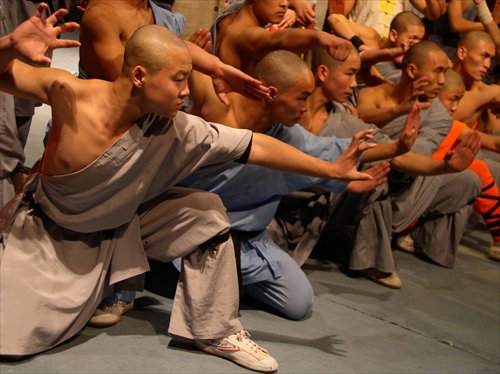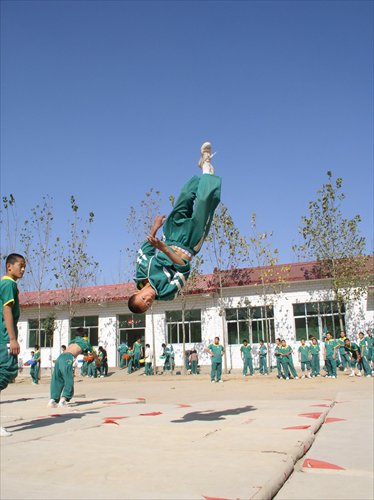Rising sons
Inside the kung fu training schools of Shaolin Temple
Located atop the western peak of sacred Songshan Mountain in northern Henan Province, the 1,500-year-old Shaolin Temple has been destroyed and rebuilt time and again, weathering attacks by emperors, warlords and now its most reoccurring invaders - modern tour groups.
In fact, not until the advent of China's kung fu movie craze in the 1970s and the internationally popular 1982 film The Shaolin Temple did annual tourism to the temple perform a CGI-like leap from 200,000 to 2 million visitors, prompting the government to list the temple as a protected heritage site.
While the venerable temple gates today see an endless stream of tourists, a more permanent population of kung fu enthusiasts exists in the outlying hillsides.
These are the sons and daughters of Shaolin, young students who have given up secular life for a strict regimen, forsaking a conventional curriculum for physical conditioning.
At Shaolin Temple, the sword is truly mightier than the pen.

Graduates of the Wushu Institute at Tagou perform nightly demonstrations at Shaolin Temple.
Crouching tigers
Opening up Shaolin to outsiders began in the mid-16th century, as military officers of the Ming Dynasty (1368-1644) court made pilgrimages to the temple to study the unique offensive and defensive moves of Shaolin priests.
The oldest and perhaps most visible school atop Shaolin is the Wushu Institute at Tagou.
The courtyard is at any given moment home to a killer bee swarm of 10,000 students of all ages, deftly demonstrating gravity-defying aerial assaults, an arsenal of weapon techniques, and the brute force of striking and grappling.
As it does not seem likely that China's central government will have future need to employ martial monks to defend the country from Wokou raiders as it did in the old days, most kung fu students nowadays end up in the police force or on private security details for China's growing number of millionaires.
But in each of their fearless eyes is that youthfully high hope of becoming the next Jet Li, China's "national treasure" who attended a kung fu training school from the age of 8 and went on to become a five-time Wushu champion and silver screen sensation.
But is real life at a Shaolin school as glamorous as its on-screen personification?

A student at Shuiku Martial Arts School performs a gravity-defying aerial maneuver. Photos: Tom Carter/GT
Wudang clan
Alongside the placid waters of Songshan Reservoir, Shuiku Martial Arts School, with only 200 students, may be dwarfed in both size and reputation by its estimable red-suited rival, but its daily drills are virtually the same.
While the working world operates on a nine-to-five schedule, life at Shuiku is backwards, with days running from 5 am to 9 pm.
In the blue light of dawn, barking instructors rouse their respective teams for a run followed by stretching, sprinting, fist push-ups and other punishing exercises.
Before lunch and then into the evening comes the fun stuff - basics, forms, applications and weapons - components of the external (Shaolin) and internal (Wudang) styles of kung fu training. The basics of most can be learned in a matter of years, but take a lifetime to perfect.
Forms, fighting techniques with the appearance of a choreographed dance, are the most elegant, but for less-graceful students, sanda sparring is more akin to street fighting, whereby the biggest and bravest don protective gear and launch into each other with fists of fury under the attentive eye of their shifu (master).
Led not by a wizened Master Po, a cruel Pai Mei or any such mythical elder with long white eyebrows, today's Shaolin shifu are young, burly and surly, some fresh out of school themselves and sadistically quick to take a bamboo cane to the backsides of their junior trainees.
Young grasshoppers
In the dark chill of night, spent students retire to their dorm rooms for a semi-normal, albeit brief, adolescent life of reading comics, watching movies, or, most precious, sleep.
Boys share rooms containing up to 10 bunks, which look and smell as you would expect.
There are currently only seven girls at Shuiku. With narrow eyes and luxuriously long hair, Feng Jingjing of Shanxi Province has been a Shaolin student for only one year but has the fluid moves of a seasoned warrior.
Despite her quiet demeanor, the 17-year-old novice shares a tempered conceit with the rest of her male and female classmates, disdaining an ordinary teenage life of classrooms and tests.
"Kung fu is far easier than English," Feng asserts while slashing a broadsword in the air with lethal precision.
But what of the parents who are paying for these pricey classes? For them, kung fu is an alternative investment in their child's future. And the earlier they begin, they hope, the larger the payoff.
Seven-year-old Cao Xu, who cartwheels to class instead of walking, doesn't seem to mind being away from his mother and father back in Shanghai.
Nevertheless, his parents' ambitions have obviously been instilled in this young grasshopper's mind.
"I want to be a hero … and earn lots of money!" he says gleefully.